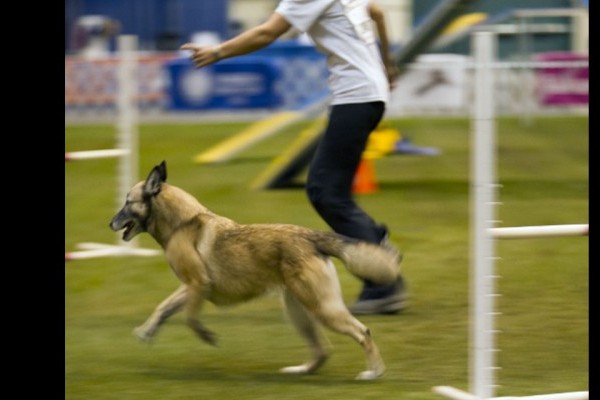Originally ran in the “Dogsport 101” column of AKC Family Dog
Dog sports aren’t only for purebreds. Since 2010, the AKC has awarded thousands of titles to mixed-breeds. Why shouldn’t your clever, athletic mix join the fun? And why shouldn’t you enjoy the bragging rights that come with putting an AKC title on your dog? Use the warm weather as an opportunity to hoist yourself off the couch and get to work. The first step is finding a sport that suits both of you best.
For a Good Listener:
Are you often showing off to your friends how quickly your dog can respond to a sit or just how well he can fetch a certain toy by name on command? Put those skills to the ultimate test in an obedience competition. Dog-and-handler obedience teams compete at three levels: Novice, Open, and Utility. Novice work includes the basic training all dogs require. They must heel on and off leash, stay, stand for a physical examination, and come when called. Those just getting started may first try the optional Beginner Novice level, which is performed on leash. At the Open level, the dog is required to work completely off leash and for longer periods. There are also jumping and retrieving tasks. Utility adds more difficult exercises, and the dog must perform scent-discrimination. The judge rewards the team performing nearest to perfect, as measured against AKC regulations. Among the consistently high achievers in this precise, subtle sport are retrievers, herding dogs, working breeds, and Poodles—breeds created to perform complex tasks on command. A good training class might awaken the obedience champ within your mix of retriever, shepherd, Rottie, or Poodle lineage, but the sport was designed for all dogs. Every year such independent types as hounds and terriers earn obedience titles.
For an Owner Who Wants a Casual Competition:
In AKC Rally, a dog-and-handler team negotiate a course of exercises according to sequentially numbered signs. The team works at its own pace, with the dog heeling from sign to sign. Each sign contains a pictograph that illustrates the particular exercise. Judges choose from 50 signs to design courses unique to each trial. Novice exercises are performed on a leash. The Advanced and Excellent classes are done off leash. Rally is less formal than traditional obedience. The handler may use signals, verbal cues, and body language to urge their dog through the course, and it isn’t scored as tightly, but the principles are the same: An energetic dog looking for a job to do is an ideal candidate.
For a High-Energy Dog:
In agility, a dog and handler navigate an obstacle course as they race against the clock. In every trial the judge will lay out the obstacles in a different sequence, and the handler must decide how to run the course cleanly and efficiently. Typical courses include tunnels, jumps, an A-frame, weave poles, and a seesaw. Dogs new to agility may do well in a Jumpers with Weaves course, which excludes the contact obstacles. Classes are divided by jump height to make competition equal among dogs of different sizes, so tiny toys and galloping giants can perform at the highest championship levels. If your mixed-breed exhibits confidence, energy, focus, and athleticism, you just might have an agility champ waiting to be discovered.
For Nosy Dogs:
Is your pup a sniffaholic? Try tracking. In a tracking test, dogs demonstrate the ability to follow human scent over a range of surfaces, from grass and dirt to concrete and asphalt. A dog-and-handler team works against the track, not against another team. Performance is judged on a pass/fail basis. Unlike in obedience and rally, where dogs respond to commands, in tracking the dog is completely in charge. Many breeds are famous for their scenting ability, but any dog, purebred or mix, should have enough nose to complete a basic track.
For a Dog Who Likes to Chase:
The Coursing Ability Test (CAT) is based on the sport of lure coursing, in which sighthound breeds (Greyhounds and their fleet-footed cousins) test their instinct for high-speed pursuit by chasing a plastic lure over a course of straight aways and turns. Unlike the hound-specific realm of lure coursing, CAT is open to all breeds and mixed-breeds.The charm of the sport is in its democratic nature. A galumphing Newfoundland or prancing Pomeranian, to say nothing of mixes of all shapes and sizes, competing in a sport usually reserved for leggy, aristocratic hounds is a sight not soon forgotten.
Originally ran in the “Dogsport 101” column of AKC Family Dog.


